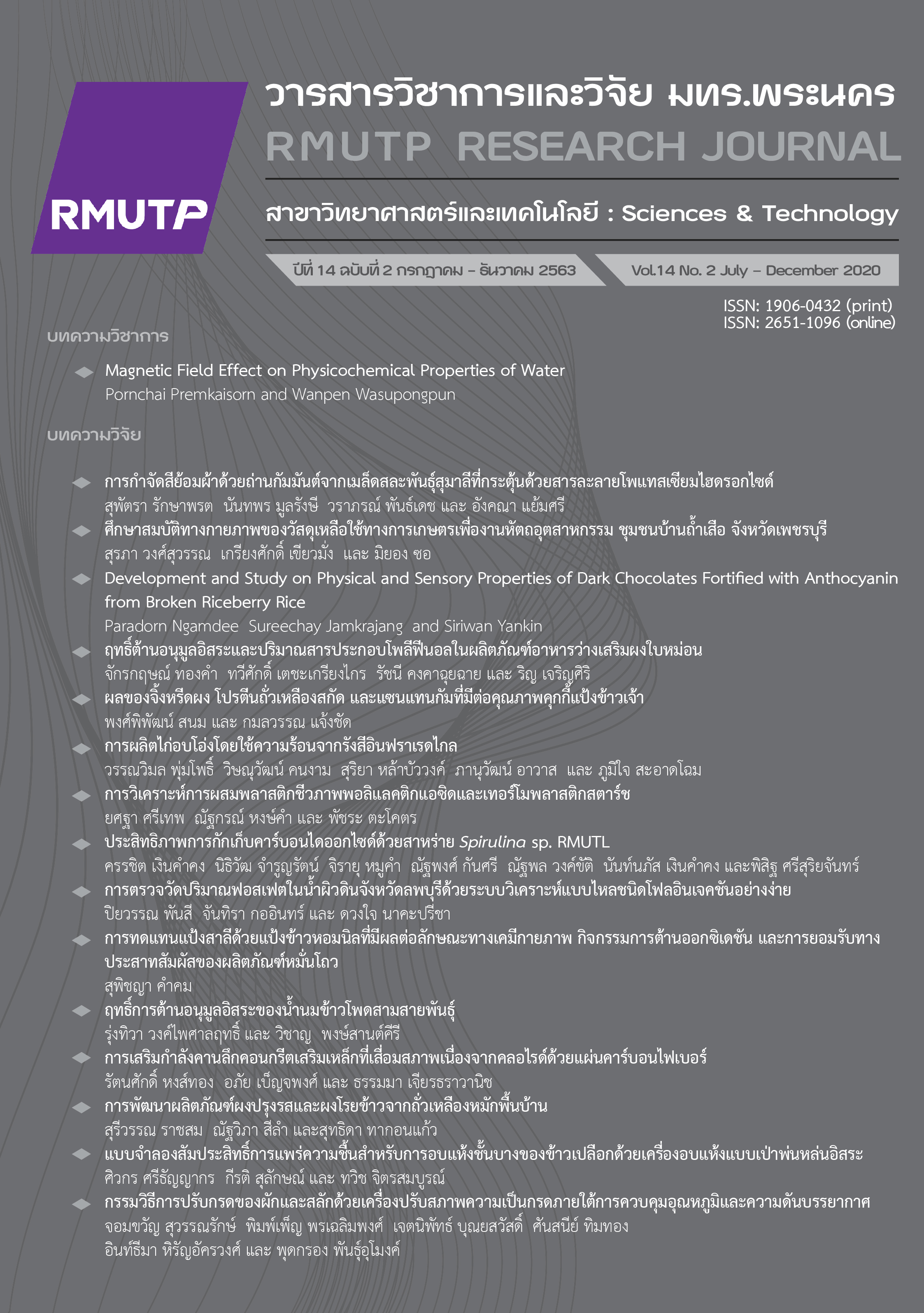ประสิทธิภาพการกักเก็บคาร์บอนไดออกไซด์ด้วยสาหร่าย Spirulina sp. RMUTL
Main Article Content
บทคัดย่อ
การเพิ่มขึ้นของก๊าซคาร์บอนไดออกไซด์ในชั้นบรรยากาศเป็นปัญหาสิ่งแวดล้อมที่สำคัญต่อโลก ปัจจุบันการใช้กระบวนการทางชีวภาพเพื่อกักเก็บก๊าซคาร์บอนไดออกไซด์เป็นสัญญาณที่ดีในการลดปริมาณก๊าซคาร์บอนไดออกไซด์ โดยเปลี่ยนก๊าซคาร์บอนไดออกไซด์ให้กลายเป็นชีวมวลในกระบวนการสังเคราะห์แสง งานวิจัยนี้มุ่งเน้นถึงประสิทธิภาพของสาหร่ายในการกักเก็บคาร์บอน และผลของก๊าซคาร์บอนไดออกไซด์ต่อการเจริญของสาหร่าย การศึกษาครั้งนี้ ได้ทำการเลือกสาหร่าย Spirulina sp. RMUTL ทำการเพาะเลี้ยงสาหร่ายในอาหารเหลวสูตรซารุค ในถังปฏิกิริยาขนาด 8 ลิตร โดยให้แสงธรรมชาติ และให้อากาศด้วยเครื่องเติมอากาศตลอด 24 ชั่วโมง ทำการเติมก๊าซคาร์บอนไดออกไซด์ (ร้อยละ 100) ที่อัตราการไหล 0.01, 0.02 และ 0.03 vvm ตามลำดับ เป็นเวลา 30 วัน ผลการศึกษา พบว่าสาหร่าย Spirulina sp. RMUTL ที่เติมก๊าซคาร์บอนไดออกไซด์ที่อัตราการไหล 0.01 vvm มีประสิทธิภาพสูงสุด คือ มีค่าอัตราการเจริญเติบโตจำเพาะเท่ากับ 0.35±0.01 ต่อวัน ค่าความหนาแน่นของเซลล์สาหร่าย 0.85±0.00 ค่ามวลสาหร่ายแห้ง 600.00±10.00 มิลลิกรัมต่อลิตร ประสิทธิภาพในการลดปริมาณก๊าซคาร์บอนไดออกไซด์ร้อยละ 96.83±0.76 อัตราการตรึงก๊าซคาร์บอนไดออกไซด์ 1,128.00±10.00 มิลลิกรัมต่อลิตรต่อวัน ค่าภาระบรรทุกคาร์บอน 20.41±0.26 กรัมต่อวัน และค่าการกักเก็บคาร์บอนเฉลี่ยต่อ 30 วัน อยู่ที่ร้อยละ 3.15.±0.02, 3.11.±0.02 และ 3.07.±0.06 ที่อัตราการไหลของก๊าซคาร์บอนไดออกไซด์ 0.01, 0.02 และ 0.03 vvm ตามลำดับ
Article Details
References
Office of Natural Resources and Environmental Policy and Planning, Report of Climate Change, 1st ed. Thailand: Text & Journal Public Company Limited, 2016.
Thairath. (2020, December 14). Climate Change. [Online]. Availiable: www.thairath.co.th/news/foreign/1723933
J.-W., Ahn, K. Hwangbo, S. Y. Lee, H.-G. Choi, Y.-L. Park, J. R. Liu and W.-J. Jeong, “Shorth communication anew arctic Chlorella species for biodiesel production,” Bioresource Technology, vol. 125, pp. 340-343, Dec. 2012.
P. Chitsanuphong, “Feasibility study of carbon dioxide recycling uning a biological wastewater treatment system for industrial sources,” Journal of Enviromental management, vol. 11, pp. 106-133, Dec. 2015.
A. Toledo-Cervantes, M. Marcia, N. Eberto and R. Sergio, “Carbon dioxide fixation and lipid storage by Scenedesmus obtusiusculus,” Bioresource Technology, vol. 130, pp. 652-658, Dec. 2012.
H. Seyedmahdi, A. Abbas, A. saeed, H. Mohamad Sadegh and M. Fatemeh, “Growht response of Spirulina platensis PCC9108 to elevated CO2 levels and flue gas,” Biological Journal of Microorganism, vol. 2, no. 8, pp. 29-36, Nov. 2014.
K. Chien-Y, C. Sheng-Yi, H. Tzu-Ting, D. Le, H. Ling-Kang and L. Chih-Shern, “Abitity of a mutant strain of the microalgae Chlorella sp. to capture carbon dioxide for biogas upgrading,” Applied Energy, vol. 93, pp. 176-183, Jan. 2012.
H. Shih-Hsin, C. Chun-Yen, L. Duu-Jong and C. Jo-Shu, “Perspectives on microalgal CO2-emission mitigation systems-A review,” Biotechnology Advances, vol. 29, pp. 189-198, Nov. 2010.
K. Wriju, G. Anuradda and M. Suparna, “Estimation of carbon dioxide sequestration potential of microalgae grown in a batch photobioreactor,” Bioresource Technology, vol. 180, pp. 370-375, Jan. 2015.
Z. Xianhai, D. Michael K., Z. Shiduo, Z. Xia, W. Mengyang, C. Xiao Dong, N. I-Son, J. Keju and L. Yinghua, “Autotrophic cultivation of Spirulina platensis for CO2 fixation and phycocyanin production,” Chemical Engineering Journal, vol. 183, pp. 192-197, Dec. 2011.
M.A.C. de Oliveira, M.P.C. Monterio, P.G. Robb and S.G.F. Lewite, “Growth and Chemical composition of Spirulina maxima and Spirulina patensis biomass at different temperature,” Aquaculture International, vol. 7, pp. 261-275, Jul. 1999.
E. Suali and R. Sarbatly, “Conversion of microalgae to biofuel,” Renewable and Sustainable Energy Reviews, vol. 16, pp. 4316-4342, Aug. 2012.
B. Melanie, D. Ignacio, D. Antonio, S. Armando Gonzalez and M. Raul, “Microalgal-Biotechnology as a platform for an integral biogas upgrading and nutrient removal from anaerobic effluents,” Environmental Science & Technology, vol. 48, pp. 573-581, Dec. 2013.
C. Alison, Use of microalgeae in wastewater treatment to remove contaminants and purify biogas, 1st ed, Canady: University of Guelph, 2011.
F. M. Salih, “Microalgae tolerance to high concentrations of carbon dioxide: A review,” Environmental Protection, vol. 2, pp. 648-654, Jan. 2011.
M. Michele Greque de and C. Jorge Alberto Vieira, “Carbon dioxide fixation by Chlorella kessleri, C. vulgaris, Scenedesmus obliquus and Spirulina sp. cultivated in flasks and vertical tubular photobioreactors,” Biotechnol Lett, vol. 29, pp. 1349-1352, May. 2007.
A. Kumar, X. Yuan, A.K. Sahu, S.J. Ergas, H. Van Langenhove, and J. Dewulf, “A hollow fiber membrane photo-bioreactor for CO2 sequestration from combustion gas coupled with wastewater treatment: a process engineering approach,” Journal of Chemical Technology and Biotechnology, vol. 85, pp. 387–394, Mar. 2010.
E.B. Sydney, W. Sturm, J.C. de Carvalho, V. Thomaz-Soccol, C. Larroche, A. Pandey, and C.R. Soccol, “Potential carbon dioxide fixation by industrially important microalgae,” Bioresource Technology, vol. 101, pp. 5892–5896, Aug. 2010.

